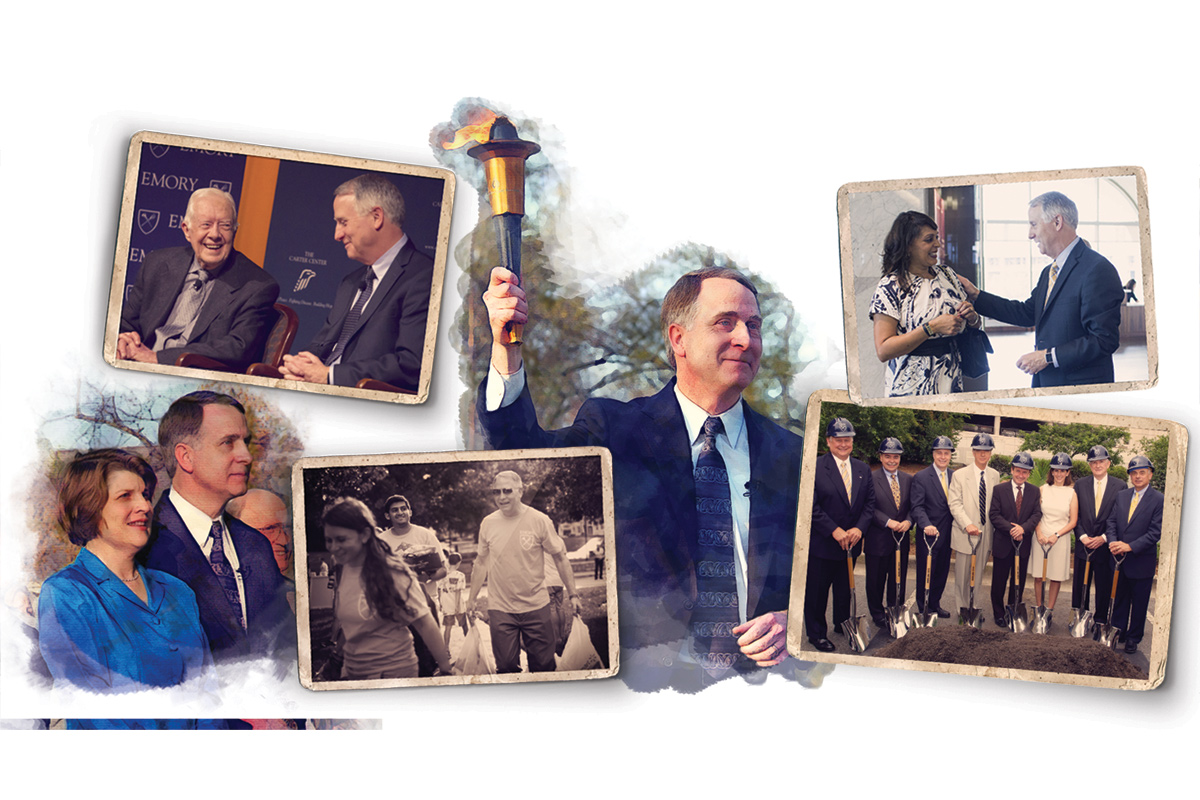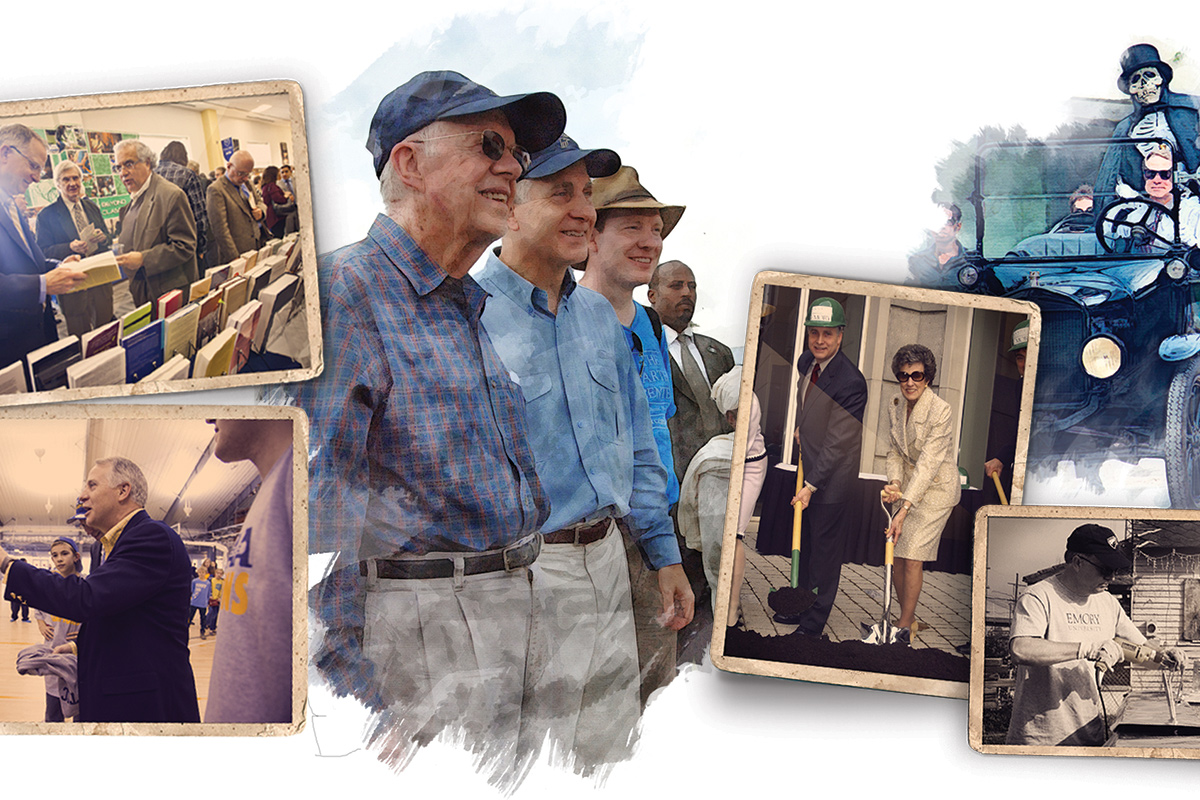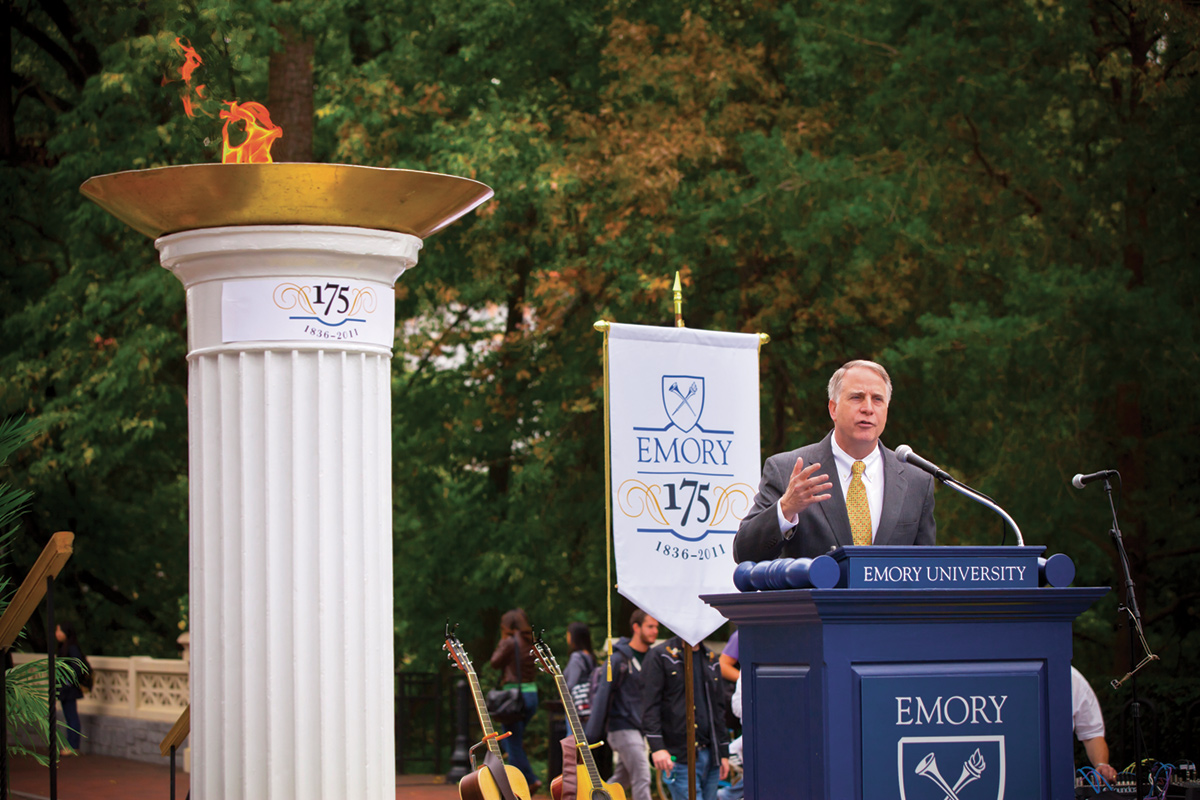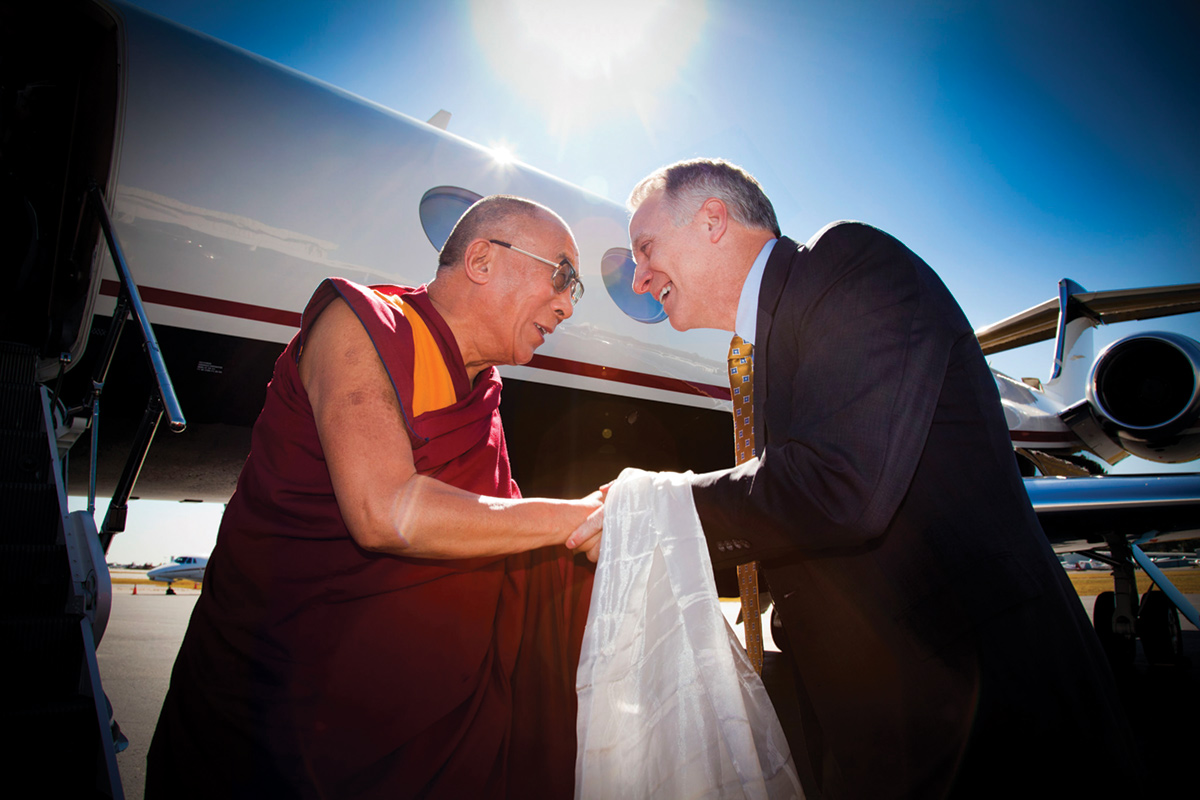Steward of the Vision
President James W. Wagner concludes an extraordinary 13-year tenure characterized by an unwavering commitment to excellence.

Ben Johnson fancied himself something of an executive search expert.
In leading the committee seeking Emory’s 19th president in 2003, Johnson—then-chair of the Board of Trustees—cautioned members “not to fall in love with any of the candidates.” As James W. Wagner held forth—“crisp and well prepared,” in Johnson’s words—Trustee Chilton Varner passed him a note that read, “Too late.”
One by one others succumbed—Johnson too.
Although Wagner had outstanding credentials—having been interim president, provost, and a former dean at Case Western Reserve University—some of his rivals were sitting presidents, older, and, shall we say, more deferential. Wagner challenged the search committee, asking, "How long is Emory going to be poised for greatness?"
The president recalls those early days and how Johnson’s confidence in him became his inspiration. “Ben says, ‘I have never been more sure of anything in my life than the match between Jim Wagner and Emory University.’ The result of hearing that, and believing it sincerely, is an enormous obligation on my part to help Ben be right,” says Wagner.
As the first order of business in his new position, Wagner set out to craft a vision statement that would position Emory for its first-ever strategic plan. He made it an energizing, community-wide exercise that he was squarely—and delightedly—in the thick of.
“President Wagner understood from the beginning the importance of inclusiveness in setting strategy,” says Claire Sterk, provost and executive vice president for academic affairs. “Many people worked on developing the vision statement and strategic plan. It was a community effort to articulate the most important values to Emory.”
Board of Trustees Chair John Morgan sees the strategic plan as the president’s central contribution, noting that “it was incredibly ambitious, put us on a higher trajectory than ever, and ensured that Emory never would lack for one again.”
Alongside the strategic plan came an updated campus master plan in 2005, which described the facilities and infrastructure necessary to meet the goals of the former.
A key feature of the Wagner administration has been the consistent reliance on mission and vision to guide development.
Everywhere he went in the first months, the president repeated the vision statement. He took ribbing for how often he invoked it, but the statement is widely respected for standing the test of time. For Trustee Emerita Laura Hardman 67C, “President Wagner embodies the vision statement. There is perfect alignment among Jim’s personal values, professional values, and the institution’s values.”
The same can be said for Debbie Wagner, whose contributions to Emory cannot be overestimated. At the outset, when curiosity about the first couple was at its highest, they would visit 10 to 12 cities a year on alumni trips. While at home, Mrs. Wagner mixes easily and frequently with community members—being a booster for Emory’s athletics teams, honoring University traditions while creating new ones, firmly establishing what had been a nascent Partners Program for the Board of Trustees, and opening up the presidential home to student groups who follow the trail of cookie crumbs straight to her kitchen.
Mrs. Wagner shares her husband’s magnetism, says Hardman, “but also has been an asset just because of who she is.” To former board chair Ben Johnson, Mrs. Wagner is “an A+, having facilitated Jim’s success in all the quiet ways he relies upon.”

Community Spirit: President and Mrs. Wagner (clockwise from lower left) during inauguration events in 2004; Presidents Carter and Wagner in a conversation highlighting the bond between the two men and their institutions; holding the inaugural torch at Oxford College; greeting faculty member and former US Poet Laureate Natasha Trethewey; breaking ground at the Rollins School of Public Health; helping a student on Move-In Day.
Cabinet maker
When the president came to Emory, the average tenure of an Association of American Universities (AAU) president was five years. As a hedge against burnout, Wagner resolved to build an exceptional leadership team.
“I was able to hire and maintain a cabinet smarter than me,” he says. “In each of their areas, they are the president—of campus life, of development, and so forth.” For his part, Wagner charged himself with three duties only, which he keeps in a note by his printer. They are to be steward of the vision, maintain the leadership team, and work for the success of others. The president has thought about leaving that piece of paper for his successor; its simplicity has belied its importance.
“All of the cabinet members,” says Wagner, “are engaged and leading at the national level. They feel trusted in carrying out their core responsibility and have sincere care for each other’s success.” Best of all, he adds, “They mentor and recruit people of that same quality at the next level down.”
One key cabinet member came on board just two months before the president—then–39-year-old Mike Mandl, executive vice president for business and administration. Ben Johnson recalls that their first conversation lasted for hours—an early sign of the synergy to come.
“The president makes all of his decisions based on principle, and he is consistent,” Mandl says. “Neither politics nor strong personalities guide his decisions. Words are insufficient to describe the impact of his leadership values, character, wisdom, and integrity on everything I do. It has enabled me to lead in a way that is consistent with who I am, and that is a gift”—one that Wagner has made to every cabinet member.

The president welcomes incoming freshmen with the Coke Toast during Orientation Weekend
Aligning the stars
The president’s ability to set a tone for attracting talent doesn’t stop with his cabinet. During his tenure, the arrival of top-tier faculty moved Emory into a new league.
Santa Ono, former Emory vice provost for academic affairs and now president of the University of Cincinnati, says, “Jim and his provosts—Earl Lewis and now Claire Sterk—recruited faculty who have made Emory fiercely competitive.”
One important measure of faculty excellence is the number who are elected to national academies. When the president began, that number was 13; it is now 47. In addition, the president’s leadership during the campaign led to the creation of 42 endowments for faculty and chairs and 358 endowments for scholarship, research, academic programs, and faculty.
Another notable advance for Emory has been the growth of its external research funding. In 2003 that figure was $319 million; it is now $572.4 million—a leap made more impressive by the fact that the national research pie is getting smaller in real dollars, yet Emory’s share is growing.
Some of Emory’s good fortune relates to right-time, right-place factors such as the presence of Georgia Tech and Atlanta’s ascendancy, as well as the work of the Georgia Research Alliance and the Georgia Cancer Coalition. Still, those dollars are a result of creating conditions to recruit the best scholars and supporting them once they are here.
“Under the president’s watchful eye,” says Jonathan Lewin, executive vice president for health affairs, “Emory health sciences developed research programs that are truly world-class in a number of areas, from vaccines to cancer to biomedical engineering. His steady, values-based leadership style has been the foundation for this remarkable growth in research impact and funding.”
The metrics associated with undergraduate recruitment also have been impressive during the president’s tenure, with applications breaking the 20,000 threshold in 2016. The admit rate has steadily fallen—implying greater selectivity—from 42 percent when the president arrived to 24 percent in 2016. According to John Latting, assistant vice provost for undergraduate enrollment and dean of admission, “The lifeblood of the University is bringing in new students, and the president makes it clear: ‘This is important to me.’ ”
From yield events in April through Move-In Day in August, the president always has signaled his commitment to the new class and to those who select the students. Latting recalls one period when reading applications was particularly taxing. He asked if the president would consider working the hallway to thank people. “Almost before I could hang up,” says Latting, “he had joined us. He went way beyond what I had imagined.”
“It is never just about the numbers with Jim,” adds Latting, who has worked in admission offices at four different institutions and has seen varying levels of interest in their presidents. “He is more concerned with who we are bringing into the community, and he trusts us to do that.”
Beyond Wagner’s support of recruitment, Sterk points to the campus master plan updates, which have created new collaborative space—brick-and-mortar as well as online—to support an innovative curriculum. Freshman Village, she says, “brings classroom lessons and cocurricular activities to the living-learning community, and this is assuredly part of the president’s legacy.”
And his drive to improve is constant. Whenever he hosts student groups at Lullwater, Wagner—or “JWags,” as they have affectionately nicknamed him—asks them, “What thing would you change to make Emory better?”
To record the answers, he keeps a notebook in the dining room. Answers have ranged from a new pasta station at the DUC to decidedly more aspirational ideas. One night recently, he asked the question and noted initial hesitation. By now, though, students know that their president has sincere interest in how they view Emory. One student piped up with, “You know, he means this. He has asked this question before and has made the changes.”

Ever Present: Wagner (clockwise from lower left) congratulating the 2015 men's basketball team on their winning season; attending an annual showcase for faculty publications; Presidents Carter and Wagner in Africa in 2005, a trip that led to the creation of Emory's Institute for Developing Nations; the groundbreaking of the Goizueta Foundation Center in 2004, with the president standing alongside Olga Goizueta; the president driving his antique car with a special passenger—the spirit of Emory, Lord Dooley; and getting the measurements right at a Habitat for Humanity build.
Marshaling the resources
In addition to initiating the strategic plan, heading a comprehensive campaign was another major deliverable for President Wagner. To widespread dismay of many at Emory, the economic downturn in 2008 coincided with the announcement of the public launch of the campaign.
When all was said and done, however, a campaign waged amid adverse circumstances succeeded spectacularly, raising $1.7 billion, well above goal. Susan Cruse, senior vice president for development and alumni relations, says Wagner deserves much of the credit; whether it was flying where needed to meet prospective donors or hosting intimate dinners at Lullwater, the president managed multiple, high-level solicitations.
“The president sets the tone for philanthropy all the way down,” Cruse says. She and her staff admire that the president never made any of it about himself, instead shining the light directly on Emory. That makes his departure and the work of the next president easier. In the campaign, Emory made substantial inroads educating its donors about the importance of a culture of philanthropy and emerged with a more robust pipeline in place.
Under Wagner, the physical campus has been transformed, with some 25 major building projects or renovations having been completed. But, Mandl is quick to say, “It is not about the buildings; it is about what goes on in them. All that we do serves program and research expansion.”
Early on, Wagner and Mandl felt that the center of campus didn’t radiate the social and intellectual energy it should. The president wanted the freshmen to occupy the heart of campus. Today, in that very spot is Freshman Village and a weekly Farmers Market, all of it rendered more vibrant by Wonderful Wednesday’s return.
A guide to then and now is former President James T. Laney, who oversaw his own ambitious transformation of campus and formed a friendship with President Wagner. During the president’s tenure, the graduate school was named for President Laney, an act of generosity in which Laney knows that Wagner had a leading part, citing his “greatness of heart.”
“His legacy is visible everywhere,” says Laney. “By every index, the University has flourished as never before.”The engineering degree came in handy
Although the choice of Wagner, an engineer, caused initial head scratching by a few University observers, his background arguably has been invaluable for the institution that Emory has become.
As a scientist, the president has been able to help the broader community grasp that investment in fundamental science—even though it is a long process—leads to opportunities for discovery that ultimately improve the health of individuals.
Wagner also helped elucidate the important difference between health sciences and health care—underlining that the former is the scientific foundation that translates to our world-class care.
Another part of the role of Emory’s chief executive is understanding what to let go. Spring 2009, for example, brought the lowest point of the recession. “At that time,” says Mandl, “it was conceivable that every worst scenario was going to happen.”
The financial team ran extensive modeling and, knowing that personnel cuts would be necessary, the president insisted on calling in Paul Wolpe, director of the Emory Center for Ethics, to discuss the ethics of layoffs. “Ultimately,” Mandl says, “Jim’s influence was around excellence, making hard decisions, and getting the balance right.”

In 2011 Emory celebrated its 175th anniversary in style. Here, the president presides over a torch run from Oxford to Atlanta.
Partnerships that expand Emory’s reach
Supporting Emory’s longstanding relationship with The Carter Center is a duty for which Wagner has shown particular affinity. In 2005, President Jimmy Carter and Rosalynn Carter, accompanied by the Wagners, visited a number of Carter Center programs in sub-Saharan Africa. The main agenda item was how to involve Emory researchers and students in solving problems associated with poverty in low-income countries.
A year later, in 2006, the Institute for Developing Nations (IDN) was formed to promote interdisciplinary scholarship on development. “He didn’t waste a minute,” says Wagner of Carter, “in suggesting that Emory needed to be more focused on disadvantaged people. I give him credit for the notion behind the Global Health Institute, the master’s degree in development practice, and the IDN. We’re making a big difference in the developing world.”
His enthusiastic counterpart returns the compliment. “James Wagner has been a leader in applying scholarship to real-world issues,” says Carter. “He recognized that a core goal of higher education must be to prepare students to tackle challenges of poverty, injustice, and inequality, which are the root causes of conflicts worldwide. During his tenure, many international activities were initiated that have advanced Emory as a global leader in higher education.”
The partnership between Emory and the Georgia Institute of Technology, though begun decades ago, nonetheless owes much to the current presidents—Wagner and Georgia Tech President G. P. “Bud” Peterson. The two institutions have expanded their work together in directions that cross traditional academic boundaries, with joint research projects in predictive health, regenerative engineering and medicine, nursing, ophthalmology, gerontology, public health, information technology, law, chemistry, and psychology.
After several years of working with Peking University, Wagner and Peterson announced—in February 2009—a joint biomedical engineering PhD program that would pair the Emory/Tech Wallace H. Coulter Department of Biomedical Engineering with the Department of Biomedical Engineering at Peking University. Then-chair of the Coulter Department, Larry McIntire, says, “The infrastructure will allow our students and faculty to conduct research and business in a global arena and prepare them to become international leaders in the 21st-century biomedical engineering industry and academia.”
Shortly after Jere Morehead assumed the presidency at the University of Georgia, he and Wagner amplified their collaborations, focusing especially on infectious disease. The two institutions currently are working together on grant- and contract-funded projects totaling more than $65 million, including a Center of Excellence for Influenza Research and Surveillance and a malaria research consortium, both funded by the National Institutes of Health.
The president’s biomedical expertise was key to the Queensland Emory Development Alliance—a 10-year partnership established in 2012 among the University of Queensland, the QIMR Berghofer Medical Research Institute, and Emory to collaborate on new drugs and vaccines for treating cancer and infectious diseases. By coming together in this way, the three institutions have leveraged additional industry, government, and philanthropic support.

Good Company: The two spirits of Emory (clockwise from left); Wagner with Stuart A. Rose, the namesake of the newly renovated Manuscript, Archives, and Rare Book Library; President Wagner entering a Convocation celebration at Glenn Memorial; commemorating the National Cancer Center designation for Winship Cancer Institute in 2009; bidding welcome to a new class of students and their parents; with Sir Salman Rushdie, who joined Emory in 2006 as Distinguished Writer in Residence; sharing the Commencement stage with Congressman John Lewis.
Leader on the national stage
On November 24, 2009, the Office of the White House Press Secretary announced the creation of the Presidential Commission for the Study of Bioethical Issues. The chair would be President Amy Gutmann of the University of Pennsylvania, with Wagner serving as vice chair. In the words of President Barack Obama, “As our nation invests in science and innovation and pursues advances in biomedical research and health care, it’s imperative that we do so in a responsible manner. I am confident that Amy and Jim will use their decades of experience in both ethics and science to guide the new commission in this work.”
With that began a series of projects that included a report Wagner coauthored with Gutmann in February 2015 titled “Ethics and Ebola: Public Health Planning and Response.”
“Our work on this report highlighted for me two of Jim’s greatest, among many, strengths as a university leader: his deep empathy for humankind and his incredible pride in the people at Emory University, who so fearlessly, expertly, and compassionately responded to this crisis,” Gutmann says.
Another major focus for Wagner has been leadership in the AAU. Hunter Rawlings, former AAU president and now interim president of Cornell University, describes Wagner as one of the more active presidents and is grateful for Wagner’s taking on the somewhat ticklish job of chairing the membership committee. Says Rawlings, “That is a fairly burdensome responsibility because the committee makes judgment calls that are sometimes difficult. Jim chaired that committee with great seriousness.”
Among many honors that have come the president’s way are election as a Fellow in the American Academy of Arts & Sciences (2009) and being named a Charter Fellow of the National Academy of Inventors (2013). Emory’s engineer-president also received an honorary doctor of engineering degree from the University of Notre Dame in 2012. Says Provost Tom Burish, “Notre Dame often awards an honorary degree to a person deemed to be an extraordinary leader, who has advanced not only his or her own institution but also higher education. We honor people whose decisions reflect a clear moral compass. Jim is clearly such a person.”
The ‘redoubtable sailor’
“I have seen him sail,” Jim Laney says of Wagner. “He is a redoubtable sailor. He knows how to weather all conditions. That skill has helped him in leading the University.”
Like all sailors, the president has known rough seas. For instance, John Latting discovered in 2012 that the University had been misreporting admission information. “I was impressed by the way the president handled everything,” Latting says. “It was squarely taken on. It wasn’t, ‘How are we going to talk about this?’ It was, ‘What is the right thing to do?’ ” Among other improvements, more stringent reporting practices resulted.
In the winter 2013 Emory Magazine, the president’s letter referred to the Three-Fifths Compromise of 1787. When Professor of History Leslie Harris read the letter, she recalls thinking, “This is not all Emory is and all that we have done,” thinking of the president’s support of the five-year Transforming Community Project carried out under Harris’s leadership. An intense period of soul searching ensued for Wagner. “What I learned,” says the president, “which is huge, is the difference between apologizing and asking to be excused. I now can look at people and say, ‘I was wrong; please forgive me.’ ”

A special friendship exists between the president and his Holiness the XIV Dalai Lama
A one-word university
The president is fully at peace with his decision to retire from Emory, if a bit wistful. He recognizes that his contact list will shrink quite a bit once he leaves office.
What will he miss? Baccalaureate, for one. He talks about the “highlight every year being the Commencement procession. I am the last one to come in. When I turn the corner to go down that aisle, I stop for a second or two to appreciate the range of emotions: pride, regret, hope. It is deeply meaningful to me.”
What would he change? He would like to have gotten to know poet Seamus Heaney better. “We would,” he predicts, “have had a ball together.” As it is, he has some pretty powerful friends—His Holiness the XIV Dalai Lama being one of them. The spiritual leader has written Wagner a letter commending him on his accomplishments and wishing him well.
Wagner is exceptionally proud that Emory has become a “one-word university.” Previously, he notes, we were a mouthful, “Emory University in Atlanta, Georgia” when mentioned in mainstream press accounts. Now virtually all media organizations refer to the University simply as “Emory.”
The president is conscious that his legacy will be determined by others. He does have one wish, however. “I would like people to say that I did my part to preserve and deepen the ethical imagination and ethical practice here. That would feel great.”
Through the years, one criticism has been that Emory is too good to be great. Wagner disagrees. “Good guys can finish first,” he says. “We don’t have to give up the goodness for the greatness.”
Asked what he would write if he left a letter for the next president, Wagner talked about growing up in Maryland and knowing about the building of the Washington Cathedral, which was started in September 1907 when President Theodore Roosevelt presided over the laying of the foundation stone. It was 83 years later when construction was completed.
Given the more than eight decades of construction, says Wagner, “Imagine what it must feel like for a stonemason to turn it over to the next person. What I would say to Emory’s next president is, ‘I think I laid a good course of stone here. I am grateful to have done so and want to encourage you to build upon it.’ "


